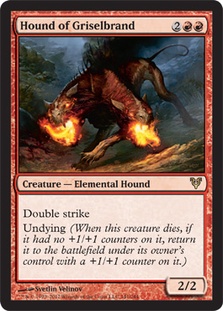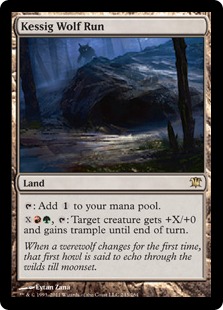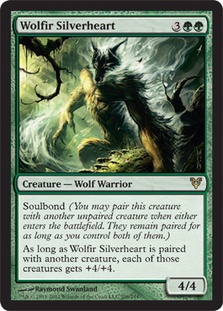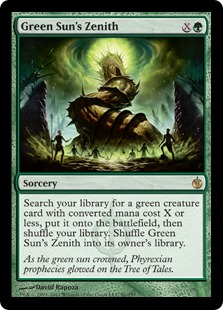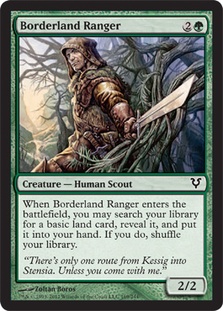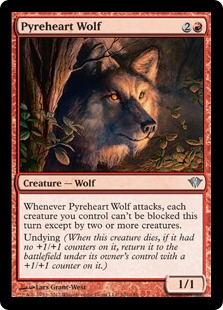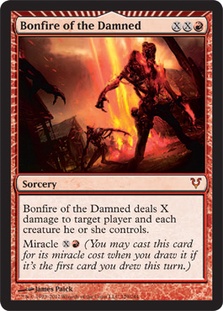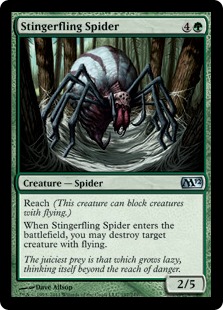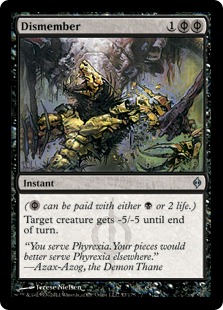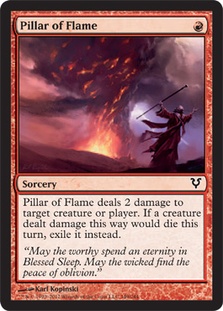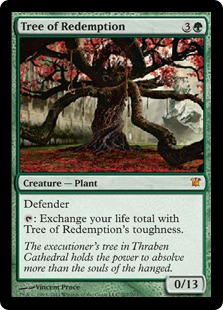I had planned to write this article a while ago, but furious testing for my upcoming WMCQ and PTQ interfered. I also wasn’t particularly keen on everyone at the event having the list. I had started brewing with Hound of Griselbrand when I was still in Barcelona for the last Pro Tour. There I had seen the raw power of Wolfir Silverheart, which made me want to go one bigger by pairing it with my favorite Hound.
Hound of Griselbrand has gone almost unseen throughout the early weeks of this Standard format. Once you play with it, I think you will agree that this will not be the case for much longer. Most people see this guy as simply a 2/2 double striker for four mana. Undying is obviously a great ability, but this guy is still a four-drop; four-drops have to be pretty impressive these days. Huntmaster of the Fells, Hero of Bladehold, and Restoration Angel are all awesome, but in my brief experience I’ve found Hound to be better than all of them in the right context.
Hound on its own is fine. It will leave you with six power post Day of Judgment. It stares down Strangleroot Geists and Geist of Saint Trafts. Its smaller half will trade with a Mirran Crusader or Hero of Bladehold, and its larger half can take down a Titan. The Hound’s true value, however, is in combination with the likes of Birthing Pod, Wolfir Silverheart, and Kessig Wolf Run.
I started thinking about Standard the second that round 1 of the Pro Tour began. As far as Block Constructed was concerned, I had finished any deckbuilding I could do and I was eager to jump into my next project. Avacyn Restored was not yet out on Magic Online and being in Europe, I didn’t really have a chance to get in any actual games. All I had was a few ideas and disinterested responses from the people I was travelling with.
I would say things like "If they Day [of Judgment], you can just cast Hound, Pod it into Zealous Conscripts, give your Hound haste, and attack for nine!" or, "Podding a Hound into a Silverheart is 22 power!" While the people I talked at were, for the most part, completely disinterested, they did occasionally unwittingly contribute. Comments like, "You’re only going to play one Hound, so it’s pretty unlikely you’ll have it in hand when they Day," were intended to shout me down but inevitably just made me want to play more of them.
Once I actually started playing with it I was blown away. I felt like I had found a more powerful and consistent deck than either G/R Aggro or Naya Pod. Hound was the glue holding it all together. The biggest struggle when building Pod decks is to have a real deck when you don’t draw a Pod.
Pod decks tend to pack a lot of mana dorks and situational one-ofs, which in turn creates inconsistency. The Naya Pod deck from PT Dark Ascension had Gavony Townships to turn its efficient but dorky threats into an actual army. While I love Gavony Township, I didn’t like the somewhat clunky mana in Naya, and I certainly wasn’t going to make it any better by adding Hounds.
Green Sun’s Zenith and Kessig Wolf Run seemed like solid ways to add consistency to non-Pod draws, with the bonus of being awesome with Hound. Greens Sun’s Zenith will fetch a mana dork to enable a Hound on turn 3 and later in the game, either a Wolfir Silverheart or a Primeval Titan to push it over the top. I decided that I would try just G/R to see what would happen.
Creatures (23)
- 2 Llanowar Elves
- 4 Birds of Paradise
- 1 Acidic Slime
- 2 Borderland Ranger
- 1 Primeval Titan
- 1 Stingerfling Spider
- 3 Strangleroot Geist
- 1 Huntmaster of the Fells
- 1 Pyreheart Wolf
- 1 Zealous Conscripts
- 2 Wolfir Silverheart
- 4 Hound of Griselbrand
Lands (24)
Spells (13)

Overall, the power level of this deck has impressed me. Unless your opponent is applying a lot of early pressure, you will generally be able to easily establish a superior board. Hound of Griselbrand and Kessig Wolf Run are able to push lethal damage through just about any board.
The rest of the deck is just there to help assemble the pieces should the game go long. Green Sun’s Zenith doesn’t find the Hound itself, but it does find you whatever help the Hound might need. Borderland Ranger and Primeval Titan will ensure a steady flow and a sufficient quantity of lands.
Wolfir Silverheart means you won’t need to worry about opposing first striking creatures. Double strike also allows you to ignore things like deathtouch and lifelink. During a PTQ, my Hound was blocked by two Wurmcoil Engines and a Batterskull Germ. My opponent was at 24 and took lethal damage.
The nature of the Hound-Zenith combination is that it can win quite quickly if they don’t have blockers or removal. You can also just Strangleroot them as G/R Aggro can. This deck doesn’t have a speed at which it usually kills. It’s more about creating a ridiculous board after which doing them twenty generally just takes care of itself.
When you are playing it, focus on this rather than trying to kill your opponent early. Even if you are playing against control, just improve your board. Now I don’t just mean that you should just keep on playing out creatures, as this will increase your vulnerability to sweepers. You can improve your board with additional Birthing Pods, more lands through Titan, and more undying creatures if they aren’t playing Terminus and the like.
The two different three-drops look terrible, which was my major hesitation when building the deck in just two colors. To say that I was impressed with how they played would be a massive understatement. Borderland Ranger is a card that we did not have access to pre-Avacyn Restored, and it is the perfect fit for this deck. Smoothing out mana screwed draws is really important, and this was one very frustrating element of Naya Pod. With Green Sun’s Zenith and Strangleroot Geist you can almost always find a Ranger with your first Pod activation.
Pyreheart Wolf has been the perfect complement to Ranger in the three-drop slot. When you have lands you just want to Pod into some value, which is exactly what the Wolf offers. Blade Splicer was sweet, but the ability to turn Pyreheart Wolf into multiple four-drops has come up a number of times. The Wolf’s ability has also been reasonably good. It’s not quite good enough to consider playing in a non-Pod deck, but I have found the ability relevant in a bunch of situations. For example, your opponent won’t be able to stabilize with just a single Wurmcoil Engine.
The next strangest thing I found about the deck was how unnecessary Huntmaster of the Fells actually was. Don’t get me wrong; I love the card. It’s so good at stabilizing your board as well as threatening domination. I was playing four of them initially. I tried to ignore my deckbuilding instincts dictating that it couldn’t possibly be right to cut such an amazing card.
That being said, I was constantly siding it out, I was never fetching it with Green Sun’s Zenith, and I was instead casting Hound or Birthing Pod when I had four mana. The card was just not a great fit for the deck. I like keeping one of them, as you’ll occasionally want to Green Sun’s to gain some life and create an extra body, and it is a little better than the Hound against an opposing Vapor Snag.
A situation that has come up for me a number of times is when you Pod a three-drop into a Huntmaster and then pass the turn. As you haven’t played a spell that turn and provided your opponent doesn’t have an instant, your Huntmaster will immediately flip during your opponent’s upkeep.
Zealous Conscripts is another card I want to talk about. I think this card has had or will have the biggest impact on Standard of any new card. It completely changes how people will build decks. Everyone thought that with the printing of Cavern of Souls ramp decks would become a lot better. Conscripts completely changes that. Tapping out for a six- or seven-cost creature has never been as dangerous. After playing this card I can’t imagine myself playing Ramp at all, not to mention Frites.
There are a lot of matchups that you can beat just by playing four Conscripts postboard and having Pods to find them. Conscripts does some amazing things in this deck, like giving you the ability to untap your Birthing Pod, giving your own creature haste, or stealing an opponent’s creature and sacrificing it to your Pod. This card actually does everything.
As far as new cards go, none gets any better than Bonfire of the Damned. Having the option to play removal and/or sweepers in a deck that relies upon maintaining a high creature count is quite a luxury. This deck plays enough mana acceleration that you can hard cast Bonfire for two with relative ease, which should generally be enough to take out your opponent’s board in most matchups.
Lingering Souls and hexproof threats become less problematic. In Pod mirrors or against other decks that are looking to swarm the board, this card is always ridiculous. Then there is its miracle text. Quite a few games will get to the point where you are horribly behind until you topdeck a Bonfire. For example, your opponent might have three Sun Titans and a Gideon Jura, but if you have seven mana you still might just win.
The last maindeck card I want to talk about is the seemingly out of place Stingerfling Spider. Yes, it’s a bad card. No, I’m not cool with that. To give an adequate explanation of this card choice, I will have to first explain the Delver matchup. It is, without doubt, the most important matchup for any deck in this current format.
All of the cards that make this deck so amazing are bad against flyers and against Vapor Snag. Hound of Griselbrand, Wolfir Silverheart, and Kessig Wolf Run all gain you no value in the face of super Unsummon. If they have any sort of pressure you can’t reasonably expect to race them. All of your red and green potential Pod targets are ineffective against flyers.
White gives you access to Fiend Hunter, Geist-Honored Monk, and Elesh Norn, Grand Cenobite. The best cards in G/R are Daybreak Ranger, Tormentor Exarch, Stingerfling Spider, and Inferno Titan. Given that I didn’t want to play more than one of these main, I had to find the best fit. Daybreak Ranger and Inferno Titan seemed like the best maindeck cards and they were better against non-Delver decks, but they weren’t enough to improve the Delver matchup to an acceptable level. Spider, on the other hand, was fantastic.
Stingerfling Spider will kill a Restoration Angel or a Delver of Secrets, and it will hold off Spirit tokens as well as a Geist of Saint Traft. Without a Sword of Feast and Famine they certainly aren’t getting through. Even if they have a Vapor Snag they had better kill you that turn, lest the Spider return to pick off another flyer.
It is also the perfect cost and color to maximize accessibility. If you had a Pod instead of a Green Sun’s Zenith, you have plenty of four-drops to sacrifice. While it is pretty close to being blank in most other matchups, I felt the Delver matchup was important enough to warrant one. If for some reason you don’t expect to face a lot of Delver, I would strongly advocate that you turn it into the fourth Bonfire of the Damned.
I’m not going to go into much depth as far as sideboarding is concerned, but I will take you through the plan for Delver as it is quite important. I’ve managed to get my postboard matchup to a very impressive point by doing this:
-1 Primeval Titan
-1 Zealous Conscripts
-2 Wolfir Silverheart
-3 Hound of Griselbrand
-1 Birthing Pod
+3 Huntmaster of the Fells
+1 Stingerfling Spider
+2 Dismember
+1 Pillar of Flame
+1 Phyrexian Metamorph
The matchup postboard is just about adding more and more Huntmasters and Spiders to the battlefield. This plan is amazing provided you have enough time. Unless your opponent has an early Delver of Secrets (the reason for which you are bringing in more spot removal), this should be relatively easy. These cards aren’t amazing in general but they are great against their early Delver draw, and these are usually the only games you will lose.
As far as the other matchups go, there are ones where Conscripts are amazing and you’ll want the full set of four. There are also the matchups where you’ll want more removal. For example, against decks sporting Wolfir Silverheart you really want to be bringing in Dismember. On the other hand, against Zombies or super aggressive decks, you’ll want Pillars of Flame and the Tree of Redemption.
It’s pretty straightforward really. Choosing what to side out is where things get a little trickier. Taking out the Stingerfling Spider is a pretty easy decision, as is the Zealous Conscripts and the Huntmaster of the Fells. These aside, I never take out the Green Sun’s Zeniths and usually not the Hounds of Griselbrand or Birthing Pods, as these are your best cards.
In summary, I’m a big fan of this deck right now. It is doing powerful things, and it is doing them consistently. Super aggressive decks are tough to deal with, but you definitely have the tools to fight them. Decks that aren’t trying to kill you as early as possible are really going to struggle with your Pods and undying threats. And when your opponent casts a sweeper and then gets smacked for at least six on the following turn, it’s just rude.
As always, thanks for reading, and I look forward to responding to your comments.
Sledgesliver on Magic Online

